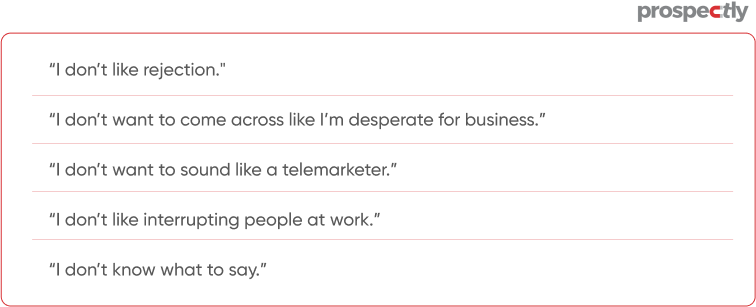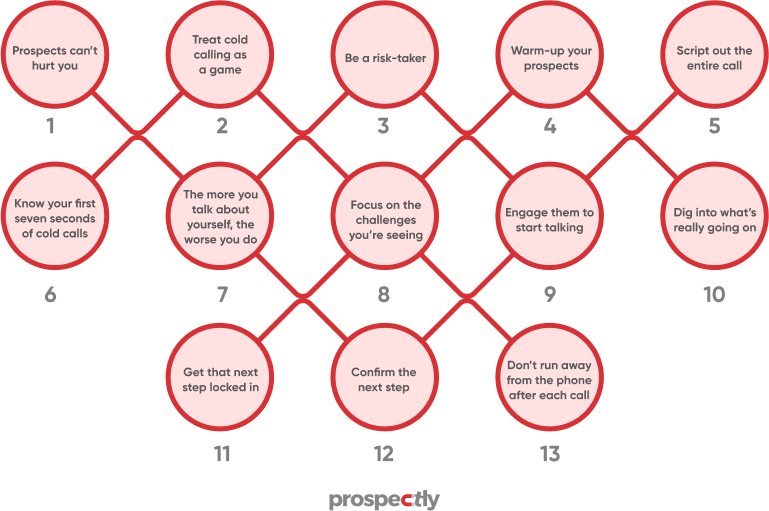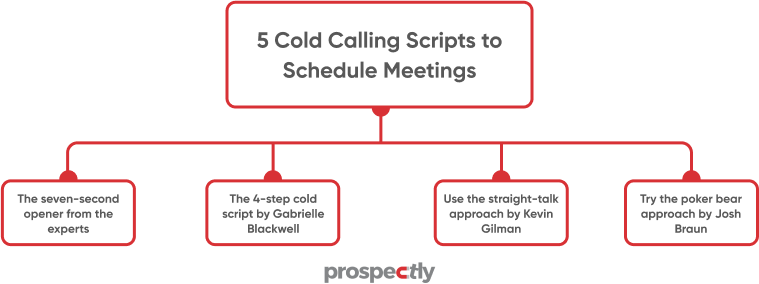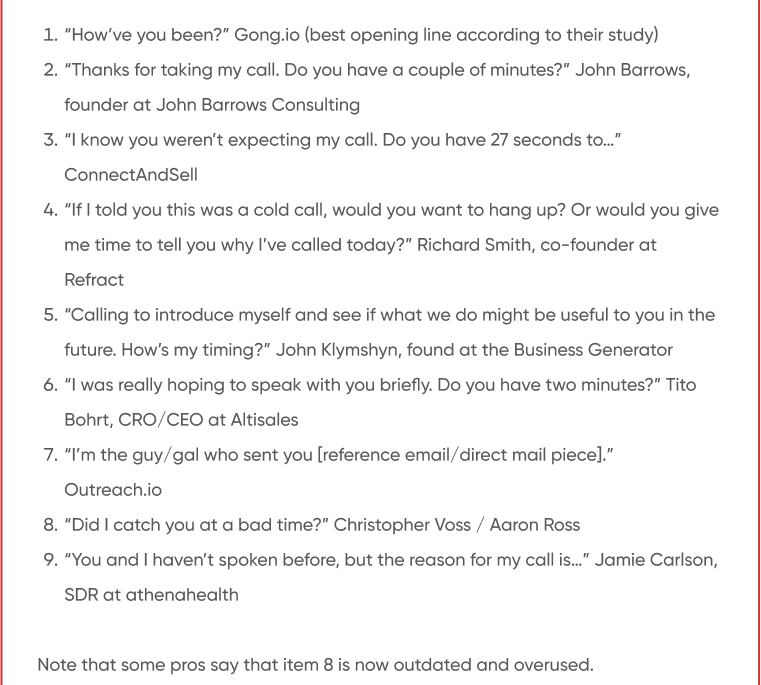Cold calling scripts: 13 steps and 4 script templates to close more deals

Some sales reps develop goosebumps when their managers suggest cold calling as a prospecting technique. Other reps close more deals using proven cold calling steps and scripts. If you’re in the first group, read this guide to learn how the pros use outbound calls. You can also polish your techniques even if you’re already flying high by reading what other experts do.
First, let’s uncover the meaning of cold calling.
What is cold calling?
Cold calling is when sales representatives reach out to individuals who have not previously shown interest in the products or services the rep’s company sells. Salespeople can use cold calls through phoning or telemarketing or door-to-door selling.
Many sales professionals agree that cold calling is one of the challenging outbound prospecting techniques. Even the stats seem to agree with them.
The success rate for cold calling might depress you. It’s 2.5%. Way low. Does this mean you should stop reading this guide and give up cold calling? Not too fast.
Here’s something to cheer up your spirits as a cold caller.
- 60% of customers accepted a call from sales representatives in the previous year.
- 75 % of prospects from different sectors attended a sales meeting due to cold calls.
That’s encouraging. However, Kelly Robertson, the President of Robertson Training Group, notes that many salespeople fear cold calling like the Omicron Covid variant. As a result, they experience unsuccessful cold calls.
Here’s why.
Why do some salespeople swear they’ll never use cold calling?
Sales professionals have many excuses for not using cold calling for prospecting. According to Kelly, they say:

Here are two more factors that discourage reps from trying cold calling.
Cold calling is like climbing Mt. Everest.
If you go by the cold calling success rate, it’s pretty clear that cold calling is difficult. It doesn’t give you instant results. You must put in a lot of effort, time, and patience.
“It takes multiple attempts and a bulldog sense of persistence to finally connect with decision-makers,” Kelly says.
The need for instant rewards
Let’s agree that making a sale after a successful phone call brings a sense of satisfaction and achievement. But cold calling may delay the celebration of success. That’s because you may suffer rejection after rejection.
If you’re looking for instant gratification, cold calling may humble you. Instead, you must have the “ability to postpone the pleasure of getting the reward and developing the discipline to work through the pain and challenge of making dozens of calls with little to show for it.”
That’s the spirit and resolve you need to excel in cold calling. Check out below the practical steps to remove fear and cold call like the pros to win more deals.
13 steps to cold calling from the pro
You can take your cold calling to the next level if you follow the advice below of thriving salespeople.

- Prospects can’t hurt you
One of the fears of sales reps is rejection. It’s a normal feeling, especially if you’ve never made cold calls. As a result, you hold back from taking risks or even making the first cold call.
There are no risks of cold calling. Also, there’s nothing potential customers can do to hurt or report you. Gather your courage and make the first phone call. If you mess up or the call fails, make another one.
As you make more cold calls, you gain confidence. Take risks.

- Treat cold calling as a game
See cold calling as a game of numbers because it’ll take you tens of calls to connect with the right person willing to talk. Many of the calls you’ll make will get you nowhere.
To get a scheduled meeting, you’ll pass through many roadblocks. You can cope with unsuccessful cold calls if you start enjoying the ride. Have fun even if the prospects give you a hard time.
The more challenging they become, the more you should up your game in outbound calls.
- Be a risk-taker
Earlier, we mentioned the importance of taking risks to boost your chances of success. Go for broke in your cold outreach, if possible. When a call goes south, you need to be bold enough to bring your conversation back on track.
Willingness to take risks prepares your mind to accept that mistakes are expected. Even if you make a call that sucks, you can lessen the pain of disappointment. You’ll see your blunders as stepping stones to success.
Also, remember that you must get your numbers no matter what. If 100 calls are your target to win that scheduled session, stick to the KPI. You’ve nothing to lose even if all the calls yield zero results.
Here’s a cold calling tip: “some will, some won’t, so what, next.”
- Warm-up your prospects
You can improve your cold calling success rate by warming up the conversation. It means incorporating other prospecting campaigns over a month or so before your cold call. You can do some things like cold emailing, social media engagement, or even stopping by the prospect’s office.
It would be best to have a cadence involving 20 touches or so before you call the potential buyer. They’re likely to be receptive when you connect with them by phone.
Turn your cold calling into warm calling.
- Script out the entire call
Some salespeople think it’s a bad idea to script out a cold call. They say it makes them sound scripted. But they have watched their favorite movies or TV shows with scripted speeches.
The actors sounded natural because they spent plenty of time practicing until their conversations didn’t look scripted. A cold calling script keeps you on track and focused.
- Know your first seven seconds of cold calls
It may sound trite, but you must know how to introduce yourself. That’s because if you get your seven seconds right, you can move the prospect to the next step of your dialogue.
The first seven seconds buy you the next 25 seconds, and throughout the call, you keep on fighting for the next 25 seconds. Know the exact words you’ll say in the introduction.
You can use specific lines to grab the prospect’s attention. One example is ‘Hey Sophia, James calling. How have you been?’
It’s different from how’re you doing. ‘How have you been’ catches a prospect off guard and makes them wonder if they know you.
- The more you talk about yourself, the worse you do
It’s easy to lose a potential client if you talk more about yourself, your company, and how great your product or service is. Your cold call will soon lose its purpose.
Instead, explain the purpose of your call right away. Be clear and say, ‘the purpose of my call is…” Remember, no one cares about your company. Your likely buyer is concerned about solving their challenges and accomplishing their results.
- Focus on the challenges you’re seeing
One way of keeping your prospect glued during the cold call is mentioning challenges in their industry. It’ll show that you’re an expert and up to date with the latest developments. The prospect becomes the center of the conversation.
Talking about industry challenges familiar to the prospect engages them. They can open up. Let the potential customer lead the dialogue and say what they care about. You’re likely to get a scheduled meeting.
Use this cold calling technique: “You know Sophia, right now I’m finding that a lot of companies in your marketplace are dealing with the following…..” Mention the challenges.
- Engage them to start talking
Why is this essential? Sales reps tend to pitch their products to make a sale there and then. Instead of nudging the prospect to talk, representatives get carried away and emphasize their solution. That’s not the way to go.
It’s too early to make your presentation in your first cold call. Instead, encourage the likely buyer to keep talking by saying, “Sophia, did any of these challenges ring true to you?” You’re inviting the prospect to converse with you by asking this question. If they say no, you can say, “Ok, fair enough. It seems like this conversation doesn’t make sense. Before I hang up, could I ask you just one more question? They’ll say yes.
Then say, “If there could be one thing you could be doing better with (fill in the blank with what you’re offering), what would it be? You could be supplying accounting software, for example.
- Dig into what’s really going on
When your prospect says they’ve got challenges in their industry, encourage them to tell you more about the problems. Rather than making a pitch to get a sale, say to the prospective customer, ‘tell me more.’ Dig in by asking questions around those pain points to keep the conversation going.
The more you ask questions, the more you’ll understand the best solution for the prospect. Also, they’ll feel engaged and that you know them.
- Get that next step locked in
Out of all the steps, it’s the most critical stage to closing out a call. That’s because you want to establish the next step.
Many salespeople believe that the purpose of a cold call or any prospecting call is to make a sale. Yes, the ultimate goal of your cold calls is indeed closing deals. But what’s more crucial before a sale is getting the next step.
The next step in your cadence could be a scheduled meeting, a webinar, etc. You should lock it in before the end of the call by sending a calendar invite. Also, make sure the prospect accepts the invite with time and date while they’re still on the phone.
- Confirm the next step
After sending the calendar invite, ensure that the prospect has received and accepted it. To confirm the next step, you could say, “Sophia, can I make a recommendation? How about we set up a meeting where I’ll come to your office, and we can dig more into this, and I can share with you some best practices on how many of our clients have solved these problems before. Would that make some sense?”
The prospect says yes.
Then say, “what would work for you?” There’ll be some small talk here. After this, ask, “Are you in front of your computer or phone or smartphone by any chance? They’ll say yes.
Then say, “I’ll send you a calendar invite right now. Make sure you check it out to see if you received it to avoid losing it in your emails. Please, accept the invite.” The prospect will agree with this advice. Be sure to receive the confirmation of the client’s invite acceptance.
- Don’t run away from the phone after each call
Remember that cold calling is about numbers or making a lot of dials. The difference between effective and ineffective cold callers is that the former keeps calling until they reach their KPI. Ineffective sales prospecting reps drop the phone after securing one meeting.
If you want to join the ranks of successful cold callers, don’t dare drop the phone even after making successful cold calls. High-flying salespeople who use cold calls know that they must complete over 50 dials every day. They use the momentum of success to do the next call and the next.
Earlier, we mentioned that you need to script out your cold calling. Let’s dive into script examples you can use to schedule meetings.
4 cold calling scripts to schedule meetings
Note one vital point. Cold calling isn’t for making a sale but to get the next step in your sales prospecting. Avoid pitching your product or service while you’re cold calling.
Cold calling scripts can help you drive your message home to avoid wasting your prospect’s time. Also, understand what problems your prospect is trying to solve by researching their industry.
Here are some cold-calling ideas that you can tweak and try out.

- The seven-second opener from the experts
The first cold calling script shows ways of introducing yourself.

- The 4-step cold script by Gabrielle Blackwell
The cold script involves an introduction, relevance, value, and launch.
How to introduce yourself
“Hey {first name}, my name is {rep’s name}.” or “Hey {first name}, this is {rep’s name} calling from {rep’s company} on a recorded line, did I catch you with a quick moment to chat?”
Give a reason for your call.
The reason for my reaching out is I was doing some research on {prospect company}, and I saw that you’re involved in {job function}
Strengthen your case by giving value
“We have a solution at {rep’s company} that is making {job function} a lot {better – faster, easier, quicker, etc.}.”
Engage the prospect through launch.
I’m curious, how are you handling that today?
After letting the prospect talk about how they’re handling their challenges, you can ask for a meeting.
Schedule a meeting.
Based on what you’re doing today, specifically {process 1, 2, and 3}, and comparing that to our customers who can do {job function} {better}, it seems like there might be an opportunity to optimize some things – and that’s what I really wanted to connect about. Would it be worth having a conversation?”
- Use the straight-talk approach by Kevin Gilman (Executive Director for American Public Group)
The cold calling technique is direct and follows the KISS principle (Keep It Short and Simple). It contains three parts: the opener, value proposition, and permission.
How to open the conversation
Hey {{first name}}, how are you?”
Make your value proposition.
{{first name}}, this is why I called. I head up sales for {{company}}, and we do a great job at {{solving x problem}}. As a {{title}}, I imagine that’s what you’re trying to do. ”
Ask for permission
“Do you have 25 seconds so I can break down for you what other companies like yours have done with us in the past?”
- Try the poker bear approach by Josh Braun (Sales Trainer & Thought Leader)
It’s a method with 4 ingredients, including permission, poke the bear and promise.
Seek permission to talk with the prospect
Hi {first name}, {rep’s name} here from {company}. I was hoping to speak with you briefly about {subject}. Do you have a minute?”
Explain the reason for your call by highlighting the pain point
“Thanks. I speak with {title} all the time who are {experiencing pain point}.”
Now it’s time to poke the bear by asking open-ended questions to nudge the potential customer to open up.
How do you make sure you don’t {experience x pain point} when {dealing with y problem?” or “What do you do to ensure you don’t {experience x pain point} when {dealing with y problem?”
Promise: keep your word of being brief.
“Sounds like this might make sense to you since you’re dealing with {pain point}. I know I promised to be brief. Would it make sense to grab a few minutes on the calendar for a demo, so you can review what your options are should the need arise in the future?”
Wrapping Up
If you think cold calling is dead, you could be listening to the naysayers. Top-performing SDRs are closing massive deals with proper cold calling steps, scripts, and the right attitude. Indeed, cold calling isn’t for those who look for instant gratification and can’t take risks.
But you can learn and practice to master all the courage and sales scripts to cold call to book meetings. You should also cold call prospects you have researched to understand the challenges they want to solve. As a result, you’ll improve your closing rate.
Sources: Predictable Revenue; Marc Wayshak & Sales Gravy



